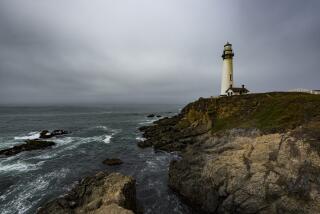Remote British Columbia Ski Area Is a Chopper Ride Away
- Share via
At least half the fun of a cross-country ski trip in British Columbia’s Mt. Assiniboine Provincial Park is getting there.
Most skiers opt for a short helicopter ride from southwestern Alberta, because the park is a relatively inaccessible, roadless wilderness wedged against the craggy border between the two provinces.
The alternative, skiing in, is arduous, requires treading carefully around potential avalanche slopes and often means camping overnight on the trail.
Our 10-minute whirlybird hop to Assiniboine began in a gravelly lot at Pigeon Mountain, about 10 minutes south along the Trans-Canada Highway in the Albertan Rockies from Canmore--principal site for the cross-country ski competition of next month’s Winter Olympic Games (Feb. 13-28).
Shortly after take-off, our five-seater aircraft, with bright maple leaf logo painted outside, bobbed in the air currents beside towering Wind Ridge, which borders the Trans-Canada Highway.
To this novice chopper passenger, a crash into the ridge seemed imminent, making the original gathering place for our group--a nearby helicopter pilots’ hangout called “Dead Man’s Flats”--seem all too appropriate.
Sky High View
Suddenly, mountain air thermals lifted us through a notch in the rocky, snow-speckled ridge top. Unfolding were magnificent views hidden from the passengers in the cars on the highway.
Below us, the deep green of conifers looked train-set-sized. Around us, as we sped along at an average of 100 m.p.h., were scores of snow-topped peaks by wide U-shaped valleys--formed eons ago by glaciers and pocketed now with snow-covered lakes.
On the return trip from Assiniboine, John Philip, our young, plucky pilot with Banff Heli Sports, detoured to give us an unforgettable close-up of the greenish tongue of the glacier well up 11,870-foot Mt. Assiniboine.
As a final bit of spice, a low cloud condition obscured our route in for the return flight, making Philip “feel” through several alternative paths before bringing us home.
The skiing also was memorable. Most heli-skiing elsewhere is geared to downhillers seeking to test virgin snow of slopes not served by chairlifts, away from the madding ski crowd. It’s only recommended for very good skiers--and even these people tell of gruesome wipeouts.
By contrast, a novice cross-country skier could have easily, and safely, taken to much of the Nordic terrain on the expansive plateau at the 7,200-foot elevation at the base of Assiniboine, which is named for a local Indian tribe.
With gentle inclines, the plateau is ideal for intermediate Nordic trekkers (such as myself), who always wanted to perfect the method, called telemarking, of going downhill on cross-country skis but could never find the right place to practice.
On one such ever-so-gradual descent, my never-better telemark form carved long S turns in powder snow that swirled around my ankles. When large flakes began to fall during the turns, my movie-crowded brain started playing the theme from “White Christmas.” If struck by a bolt of winter lightning at that point, I would have died with a smile on my face.
Miles of Powder
For advanced telemark skiers, steeper, wide-open slopes towered, conservatively, hundreds of feet high. For people just interested in cruising on skis, miles of powdery snow over rolling terrain, with views of myriad craggy surrounding peaks, make the sport a joy.
“It’s super-touring,” says Derin Kennedy, a longtime Assiniboine veteran from Tata Creek, British Columbia.
Kennedy and party were hold up in one of the Naiset log cabins, which date to the 1920s, when rugged outdoorsmen such as members of the Alpine Club of Canada convinced the government to set aside the area as the province’s third park.
The meadow just outside Kennedy’s cabin served as the helicopter’s snowy landing pad, but is covered by wildflowers in summer.
The four Naiset cabins sleep six to eight, have only bare bone accommodations, and cost $6 a night.
With snow stacked on the side to a depth where it merged with a layer coating the pitched roof, a peek into Kennedy’s cozy digs revealed bunk beds, a Coleman stove he brought for coking and the cabin’s potbellied stove used for warmth (firewood is scarce, and it’s recommended you bring some with you; it’s rationed in the park).
Also inside were several clotheslines, strung with a heavy burden of damp clothes, looking like a tenement’s backyard on wash day.
But while space and amenities are a premium in the cabins, they have a saving grace besides price--they can only be booked one month in advance.
Across the meadow and down a short snowy path is Mount Assiniboine Lodge, the plush quarters hereabouts, which is typically booked for the winter high season (March and April) six to eight months in advance.
Built of Spruce Logs
Built of local spruce logs, the two-story lodge also dates to the 1920s, when the Canadian Pacific Railway built it as a further lure to entice passengers onto its transcontinental rail line.
Canadian Pacific already had constructed a couple of grand hotels for the same purpose in nearby Banff National Park in Alberta--Banff Springs and Chateau Lake Louise. Both are still going strong and recently had multimillion dollar renovations prompted by the 1988 Winter Olympics in Alberta.
Mount Assiniboine Lodge doesn’t have the grand lobbies of its sister accommodations, but the furniture, with gleaming natural wood finishes in the small dining room, looks like it has just been picked up at a store specializing in modern Scandinavian designs. Doorways are colorfully painted with large floral patterns.
In upstairs bedrooms and in sleeping cabins nearby, a maximum of about 26 guests tuck themselves in under down comforters. Even though the lodge and sleeping cabins are heated, it’s probably wise to pack a spare pair of thermal underwear.
Park ranger Nina Holquin said temperatures often dip as low as 45 degrees below zero around Christmas at Assiniboine. March--when I visited--and April are much milder, but because the park is on the turbulent Continental Divide, the weather can be crisp at any time of year.
The popular dinner menus vary. A recent one with a Greek theme included a first course of homemade corn chowder soup. It was followed with grilled lamb, Greek salad with feta cheese, melon balls in mint sauce, spanakopeta --Greek pastry made with spinach, cheese and onions--and rhubarb pie.
Tempting Menu
A typical breakfast included fresh fruit, yogurt, hot cereal, fresh baked cinnamon buns or clafouti (a French custard with fruit). A lunch bag, for trail-side consumption, might include sandwiches, cookies and more fruit.
Along with the fresh breads, ingredients for the food, like the guests, are ferried in by helicopter.
The lodge also offers guided ski tours, including telemark runs on nearby slopes.
Of course, the most commanding slopes are not ski slopes but soaring sides of 11,870-foot Mt. Assiniboine, which towers hundreds of feet above any of the quite respectable peaks around it. Its similarity to the Swiss landmark has earned it the nickname of “Matterhorn of the Rockies.”
Barb Renner, with husband Sepp, has managed the lodge since 1983. Her enthusiasm for the mountain was typical of reactions I encountered. “When you see it,” she said, “it’s still magnificent. No matter how many times you’ve seen it before.”
The rub is this mountain among mountains is frequently obscured by clouds, such as during my visit.
Lodge rates start at $265 per person for the minimum two-night stay to $755 per person for a private cabin for two for seven nights.
Rates include all meals, guided ski tours and round-trip helicopter transportation from Mt. Shark Heliport at Spray Lake, water source for Canmore and the starting point of a hefty 16-mile hike to the lodge for summer guests who forgo helicopter transport.
In summer, when the lodge hosts hikers and fishermen, the rates are $195 for two nights to as much as $710 for seven nights. Unlike winter, children’s rates are available in summer (from $80 for two nights to as much as $350 for seven nights). Lodge space should be booked well in advance for the summer high season of July and August.
Summer Rates
Summer rates don’t include helicopter transport--because some guests choose to hike in. But the lodge will throw a helicopter in for $50 each way, the average charge by local helicopter operators to bring passengers to and from the plateau at the base of Assiniboine from around Canmore.
For more information on Mt. Assiniboine Provincial Park, including Naiset Cabins, write or call Parks and Outdoor Recreation Division, P.O. Box 118, Wasa, B.C., Canada, VOB 2KO, phone (604) 422-3212. For information on Mount Assiniboine Lodge, write P.O. Box 1527, Canmore, Alberta, Canada, TOL OMO, or call (403) 678-2883.
Other cross-country ski lodges in the area include Skoki Lodge, a 1930 vintage log cabin accommodation within a several-hour ski of Skiing Louise, one of Canada’s finest downhill resorts. Both are located in Banff National Park.
A dozen alpine lakes are on or near the network of ski trails branching out from Skoki, whose $75 per night charge includes three meals. For more details on both Nordic and downhill areas, contact Skiing Louise Ltd., P.O. Box 5, Lake Louise, Alberta, Canada, TO1 1EO, phone (403) 522-3555.
The Alpine Club of Canada’s Clubhouse in Canmore has hostel-style, shared-room accommodations at a bargain basement price, $10.50 per night for the public (club members pay $6.50).
There’s a library of mountaineering books (fitting for this historic mountaineering group), a sauna and a number of other facilities.
Nearby is the new Canmore Nordic Center, whose 65 kilometers of machine-groomed trails will be used during the Olympics in February--and open, for free, to the public at other times.
In summer, the public is invited to stay (for $10.50 per night) at the 11 mountain huts the Alpine Club manages in Alberta and eastern British Columbia. Winter access to the huts is generally restricted to club members, but you can still walk to glaciers near any of the huts in summer.
For more details on lodge and huts, contact the Alpine Club of Canada, P.O. Box 1026, Banff, Alberta, TOL OCO, phone (403) 762-4481.
More to Read
Sign up for The Wild
We’ll help you find the best places to hike, bike and run, as well as the perfect silent spots for meditation and yoga.
You may occasionally receive promotional content from the Los Angeles Times.






